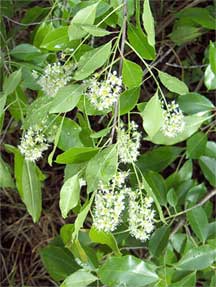There are two cherry-laurels grown in America, the native Carolina cherry-laurel (Prunus caroliniana) and the European cherry-laurel (Primus laurocerasus), both of them broadleaved evergreens. The second is perhaps the more popular, although both are dense evergreen shrubs or small trees, used especially in the Deep South.
The reason for mentioning both in this article is that there are forms of the European species hardy in the northern United States and even grown by a few nurseries in southern Canada. These broad-leaved evergreen plants are adaptable to a wide area in the East and on the Pacific Coast as well.

These plants grow in any good soil as long as there is plenty of moisture and fairly good drainage. Frequently they are used as hedge plants but when they are sheared too close they become unsightly. As specimen shrubs or small trees they do have merit, especially in shaded places.
The European cherry-laurel has leathery, lustrous, dark evergreen leaves, 4 to 6 inches long, while those of the taller growing Carolina cherry-laurel are slightly smaller. (This last species is strictly for the Deep South.) The white flowers of both are small, fragrant, profusely borne in the late spring and the purple-black, cherry-like fruits are about one-half of an inch in diameter. They are not especially ornamental or conspicuous, but they plants are valued specifically for their evergreen foliage.
One variety of the European cherry laurel well worth mentioning is the Russian form (variety schipkaensis). This has proved perfectly hardy in Boston in protected places over the years. It thrives in the gravelly acid soils as well as in the sandy soils of Cape Cod, and is being grown near Toronto, Canada, also, but is not well known. Another hardy variety, usually not over 4 to 5 feet tall but twice as wide is zabeliana.
Once the beauty of the lustrous green leaves is revealed to the flower arranger, the cherry-laurels should become extremely popular. The plants grow as wide-spreading, vase shaped shrubs and the leaves are borne alternately on the twig at regular intervals making them striking in any arrangement, especially when used as high background material.
This fast-growing plant can be cut frequently without marring the general appearance of it, thus making it an ideal plant in this respect for the home garden.
Nurserymen find they are not difficult to propagate… softwood cuttings root easily in the summer, or hardwood in the winter. Home owners who are experimenting with home propagating units could do well to add one of these plants to their experimental list. Once a small plant is started and protected over the first winter, it will quickly become one of the outstanding evergreens in the garden.



{ 0 comments… add one now }
You must log in to post a comment.